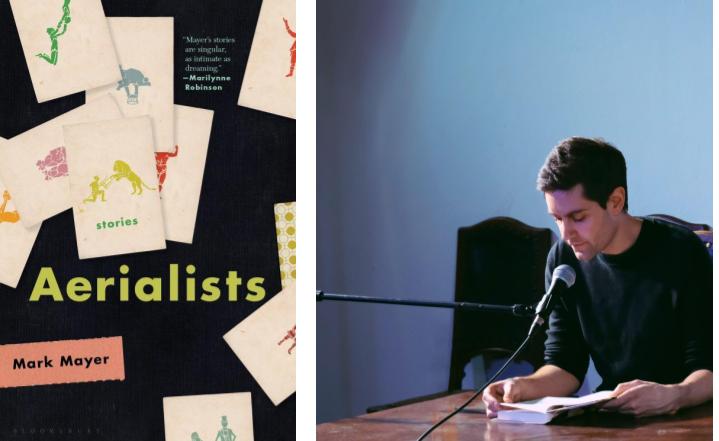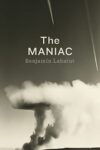Read Part One of Kelly Krumrie and Mark Mayer’s conversation here.

Mark Mayer: I think part of why I like writing younger narrators is because they’re closer to what I think we all still feel but hide from ourselves, which is the essential bewilderment of life itself. We get better and better at masking it under routine and all our various practiced understandings. But on a fundamental level, the mysteries of childhood don’t ever really go away. We just get better at ignoring them or find workarounds. And math—I see it in this book all over. It becomes this place where we can force ourselves to encounter all that’s incomprehensible because we have this very simple system of measuring what should be clear and logical and straightforward. But then you start looking more closely, and it’s like, well, a circle is a very strange thing.
Kelly Krumrie: That’s what’s so spooky about it: There is this factual yes and no part. There is the right answer and the wrong answer. I can see the thing. I know what it is. I can graph it. But it’s also totally, like, made up. It’s invisible and incomprehensible. As soon as I have a hold on something, I don’t, it just trickles out of my hands. I think that’s what’s really interesting about math in literature: A mathematical concept in a work of art can create this notion of a fact or something solid. But it’s anything but that.
What do you think? What are the effects of like bringing these concepts into a short story or into a poem?
Math’s this thing that masquerades as completely knowable and comprehensible. Everybody knows what the number four is. Everybody knows what a point is. It’s a point. It’s that which has no part. But then if that’s what it is, and you start thinking about it like how you guided your students to do . . . If it has no part, then what’s this thing that I’m looking at? It’s not a point . . . It starts to sort of zoom and become a vortex, right? You have to look closer and closer to see the thing that is actually a point, and it gives you a special kind of nausea. It’s destabilizing and defamiliarizing in a really profound way.
I know that you really love deictic words. Like I and here, where the meaning of the word seems like the most obvious thing in the world, but actually you can’t define any of those words except circumstantially. You have to think about who said them when, for what purpose. And they shift depending on all of that. I think there’s something very similar to the way the word here shifts, and the way the concept of a point kind of vortexes is that it quickly starts to destabilize on the most basic level, the kind of fundamental nature of how you’ve told your story of yourself and your world and your place.
Yeah, totally. I love those words. I think you got it right: They’re so boring and obvious. But then if you think about them for just a beat longer, they’re impossible.
You said we know what four is? No, we don’t know! We don’t know what four is. I find that really exciting. I think that when you take math language out of its context and put it in another context, it changes even more, and it can have a lot of power. Alternatively, I was just thinking about the artist Hanne Darboven who made grid drawings, not unlike Agnes Martin, but with numbers. In an interview with her, someone asked, “What do the numbers mean?” And she replied, “The numbers mean nothing!” They mean nothing! And I was like, yes, you are correct! They mean nothing. But they do when you put them somewhere. It depends on where you put them. Words can function similarly, but maybe less abstractly. Deictic words can function similarly. Pronouns can. Prepositions. Where I put it is going to make a big difference about what it means. We can talk more about that, but that might be getting into Crazy Land.
I think another piece of it, which is another kind of Crazy Land maybe, is the efficiencies of mathematical logic, whether it’s a proof or the way an equation seems to kind of move, as you read it horizontally or transform one side into another side. The elegance of that I find aesthetically inspiring for what a short story or sentence can do. I think there’s an elegance in the movement of math that short stories in particular can aspire to.
There’s an Annie Proulx short story called “The Blood Bay” that I teach sometimes, which is just like the bloodiest Western. It’s basically a set of exchanges that take place, beginning with a team of cowboys finding a corpse that’s frozen in a river and has really good boots on. They have to saw off his feet because they can’t get the boots off while they’re frozen on. So they saw off his feet, and thaw them later. Then a series of exchanges happen because of it. The last sentence of the story is, “The arithmetic stood comfortable.”—which is one of these sentences like I haven’t been able to stop thinking about since I first read it, because it does sort of describe the feeling you get at the end of a story, but also at the end of an algebraic proof: The arithmetic finally stands comfortable. Something’s been completed. There’s a sense of justice and rightness and balance that comes with that that is kind of common to narrative. Maybe we should be suspicious of that feeling of comfort, but stories do kind of give us that sometimes in the same way as math.
Oh, that is a killer sentence.
Isn’t it? It’s in her first book of Wyoming stories. I teach it all the time. And then we’re stuck for the rest of the semester talking about, like, well, you know, in Billy’s story, does the arithmetic stand?
I think when we talk about math and literature, it always comes down to, you know, prosody or something. That it’s something countable, as in poetry. It becomes a weird blob when we think about quantification and fictional texts. I’m trying to wrap my head around how to talk about it, or why to even bring it up at all.
I mean, I think math is fascinating as subject matter for all the reasons that we’ve talked about, but it’s also really fascinating as form. Every poetic form is a kind of mathematical shape. The ones that aren’t can easily be turned into one. Take a book like Alphabet by Inger Christensen with its Fibonacci sequence as a kind of ordering principle, and it suddenly starts to do really amazing, moving things.
I guess the one mathematical shape that I bring into classrooms from time to time is the Koch snowflake fractal. It looks a heck of a lot like Freytag’s triangle, which is this not very useful shape that they gave us in high school for understanding how stories are shaped. You have exposition and rising action and a climax and denouement and so on. The Koch snowflake has that kind of shape but iterated to infinity, as if every surface of Freytag’s triangle is now its own Freytag’s triangle, and every surface of that is yet another one, and so on. And why is that useful? Well, because I think we all know that a story has to have a rising action and a climax and a falling action. But how do you figure out what it is? Often, I find the place to look is the microcosm. You’re writing a story, and you have a sentence that feels just right or a scene that feels just right, or a bit of dialogue where the conflict between the two characters feels like, okay, somehow this is the key to the whole. Maybe it is the key to the whole. If you study the shape of that moment that rings true, you can unpack from it what should happen on the larger scale of the story. You can use it in the other direction, too, to revise a scene that you feel is wrong based on your larger sense of what the story’s central emotional question is. I don’t know if my students find it as exciting as I do, but it’s a day of the semester.
I think that’s the most useful explanation for the use of the word “fractal” in literature that I’ve ever heard. (I find most uses of it frustrating.) That’s probably how I’m operating when I write any kind of fiction: a really serious zooming in and zooming out and echoes on various scales.
It’s like permission to trust that your details or your images might know more than you know.
Mark Mayer’s first book, AERIALISTS (Bloomsbury 2019), won the Michener-Copernicus Prize and was shortlisted for the William Saroyan International Prize for Writing. His stories have been published in American Short Fiction, the Kenyon Review online, Guernica, and the Iowa Review. He is an Assistant Professor of Creative Writing at the University of Memphis.
Kelly Krumrie is the author of Math Class (Calamari Archive, 2022). She holds a PhD in English and Literary Arts from the University of Denver, and she lives and teaches in and around Denver. More information and work can be found at kellykrumrie.net.
This post may contain affiliate links.







